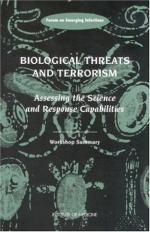|
This section contains 1,253 words (approx. 5 pages at 300 words per page) |

|
Most twentieth-century Americans found bioterrorism—the deliberate release of disease-causing microorganisms with the aim of causing devastating epidemics—unthinkable, perhaps even more so than nuclear war. Along with chemical warfare, biological warfare was forbidden by the 1925 Geneva Convention. More "civilized" nations regarded countries known to have tested biological weapons, such as Japan during World War II, with horror. To be sure, during the 1950s and 1960s, both the United States and the Soviet Union developed bioweapons programs— purely, they said, for defense in case the other side used such terrible weapons first. In 1969, however, President Richard Nixon formally ended the U.S. bioweapons program, and in 1972, the United Nations established the international Biological and Toxin Weapons Convention, in which all signatory nations pledged never to develop, produce, or stockpile such weapons. Both the United States and Russia signed it.
Confidence that no one would ever...
|
This section contains 1,253 words (approx. 5 pages at 300 words per page) |

|



